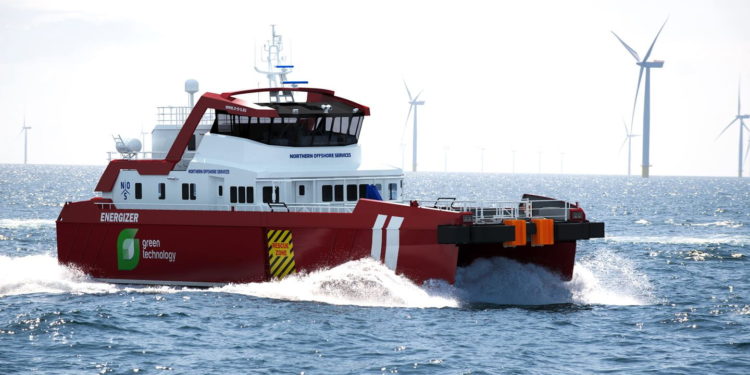Ørsted will be welcoming three new hybrid crew transfer vessels (CTVs) to aid with the construction work at Hornsea Two offshore wind farm.
The company has worked alongside Northern Offshore Services (N-O-S) and MHO-Co to develop the vessels which will take around four hours to travel to site, from their base at the port of Grimsby, on the east coast of the UK. N-O-S will deliver their 39-meter “Energizer” in Spring, whilst MHO-Co’s two 35-meter CTV’s are due to be delivered in Summer.
Ørsted’s Lead Marine Specialist, Jan Stilling said:
“The new CTV’s have incorporated large battery capacity that makes it possible to stay offshore overnight in hybrid mode meaning they’re not burning fuel for up to eight hours while the vessels keep their positions without anchoring or mooring to a buoy. The new gangways will work as additional support for the extra access required during construction on site.”
The batteries installed on all three vessels can be recharged either by power surplus, the onboard generator or via a recharging buoy system that will be tested during the construction face of the wind farm.
Both designs have been created in preparation for implementing fuel-cell technology once suitable storage for the fuel types such as hydrogen or methanol has been developed for use onboard.
The CTV will also carry Z-Bridge’s newly developed motion compensated transfer system called Bring-to-Work. This unique transfer system will be installed for technicians to access the Hornsea Two transition pieces (TPs) directly from the CTV.
Bastiaan Spruit, General Manager at Z-Bridge said:
“We are extremely proud that we have been contracted to support Ørsted’s ambition to reduce the CO2 footprint and increase safety during transfer of technicians by CTV’s. The Bring-to-Work is a fully motion compensated offshore access system. It will allow teams of four technicians to transfer in a trolley direct from the CTV to the TP platform. By eliminating stepping to the boat landing and climbing ladders this will improving safety. We see that this will also significantly reduce the required visit time per TP, lowering fuel consumption and improving operational efficiency. The Bring-to-Work system is the first offshore access system installed on a CTV that is able to transfer people direct to the TP platform elevation.”
MHO-Co’s vessels feature both a diesel mechanical and a diesel electric Inboard Performance System (IPS) driveline setup in both hulls. The diesel electrical drivelines can also be powered from the large onboard researchable battery pack during night-time and slow steaming.
MHO-Co’s Group CEO, Mik Henriksen said:
“We at MHO-Co are very happy with the award of contracts to supply four CTV’s for the construction of Hornsea Two, with two already set to work, the MHO Asgard and the MHO Apollo are the next step towards carbon neutral operation. As with our previous CTV’s we have worked with Ørsted to design superior sea keeping to support windfarms further offshore, with a high level of comfort for the technicians. These new boats will also be used to take next step technologies like hydrogen fuel cells, methanol and new types of batteries to market. MHO-Co has also been involved in the development of new ways to access turbines, such as the Z-Bridge.”
Credit: Ørsted

































